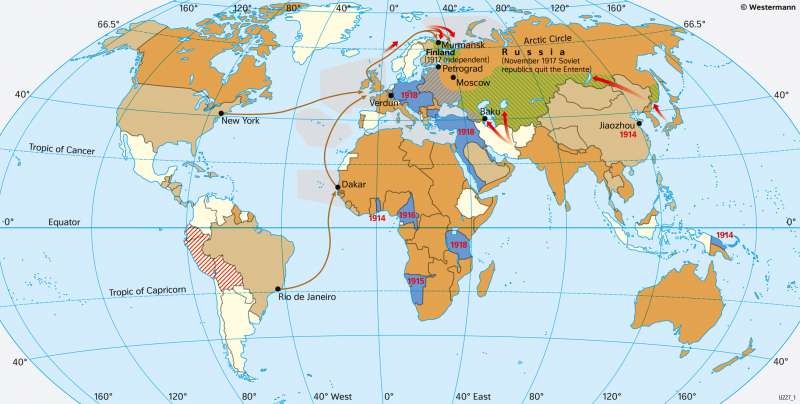The World during World War One (1914–1918)
The Age of Imperialism
978-3-14-100890-6 | Page 31 | Ill. 3

Overview
This world map freezes the four years of fierce warfare and depicts the basic constellation of forces. Two power blocs faced each other, some fronts remained hardened for years in the First World War and shifted only insignificantly for a long time.
The Schlieffen Plan
The "great seminal catastrophe of this century" began on 28 July with a declaration of war by Austria-Hungary against Serbia. Russian forces were mobilised on 30 July, Germany declared war on the Tsarist Empire on 1 August and on France on 3 August. The British entry into the war followed one day later.
The German Empire, which played a decisive role in the violent escalation, had the plan to crush France by a surprise attack and then to move against Russia with concentrated army power ("Schlieffen Plan"). Since this strategy was based on the surprise effect, the German leadership accepted a violation of Belgium's neutrality, which in turn provoked Britain's entry into the war.
The German advance initially went as planned but was stopped by the French and British at the beginning of September 1914. From autumn 1914 onwards, the surprise campaign turned into a murderous war of position, with the front stretching for more than 700 kilometres from the Dutch Westerschelde to the Swiss border. There were countless skirmishes, engagements and battles - more than 700,000 soldiers died at Verdun alone in 1916 - without any serious change in the course of the front.
The "Great Seminal Catastrophe" and ist consequences
What was historically new about the First World War was the mass use of the most modern technical means of combat, including machine guns, tanks, aircraft, and chemical weapons, which caused the number of casualties to reach unprecedented dimensions. Around 8.5 million soldiers died, 21 million soldiers were wounded, 7.8 million were imprisoned and 7 million civilians lost their lives. In addition, the civilian population was massively involved in the war effort through propaganda, involvement in the war economy, patriotic celebrations, and voluntary services. The mobilisation of all economic, technical, and human resources made the First World War the first "total war" in European history.
The political consequences of the war were serious. With Russia, Germany, and Austria-Hungary, three large European monarchies collapsed, and the Austrian multi-ethnic state dissolved. Instead, a number of new or re-established nations were created in Northern and Eastern Europe: Finland, the three Baltic states of Estonia, Latvia and Lithuania, Poland, Hungary, Czechoslovakia and the Kingdom of the Serbs, Croats and Slovenes (Yugoslavia from 1929). But the peace settlements (including the Treaty of Versailles with Germany) did not stabilize European conditions, either politically or economically.
Development towards a world war
The failure of the Schlieffen Plan also affected the Eastern Front. After initial victories, the advance of the Austrian and German units stalled. The attack there also turned into a war of position. A third front emerged in the south at the end of 1915, after Italy had entered the war on the side of the Entente. Hundreds of thousands of soldiers died in the Isonzo battles between Austria-Hungary and Italy between June 1915 and October 1917, without either side gaining a decisive advantage.
The United States remained neutral for a long time. But when Germany announced in February 1917 that henceforth it would sink all ships in the North Sea, Atlantic and Mediterranean without warning and British intelligence learned almost simultaneously of a planned German-Mexican alliance that gave Mexico hope in acquiring the US States of Texas, New Mexico and Arizona, the tide turned. On 6 April 1917, the USA declared war on Germany and, in December, on Austria-Hungary.
In a "Spring Offensive", the Germans tried to force a decision on the Western Front at the beginning of 1918. On 21 March they launched a major attack and the Entente responded with a counter-offensive in July. The decisive victory was achieved by British tanks near Amiens on 8 August 1918. In October, Austria-Hungary capitulated, and on 11 November Germany signed the armistice.
Meanwhile, in Russia, after the October Revolution of 1917, the Russian Civil War had begun, in which the revolutionaries and the anti-Bolshevik "Whites" fought each other bitterly. After the strong advance of the Whites, who received support from the USA, France and Great Britain, the Red Army succeeded - against all expectations - in reconquering all the territories controlled by the Whites by the end of 1920.




